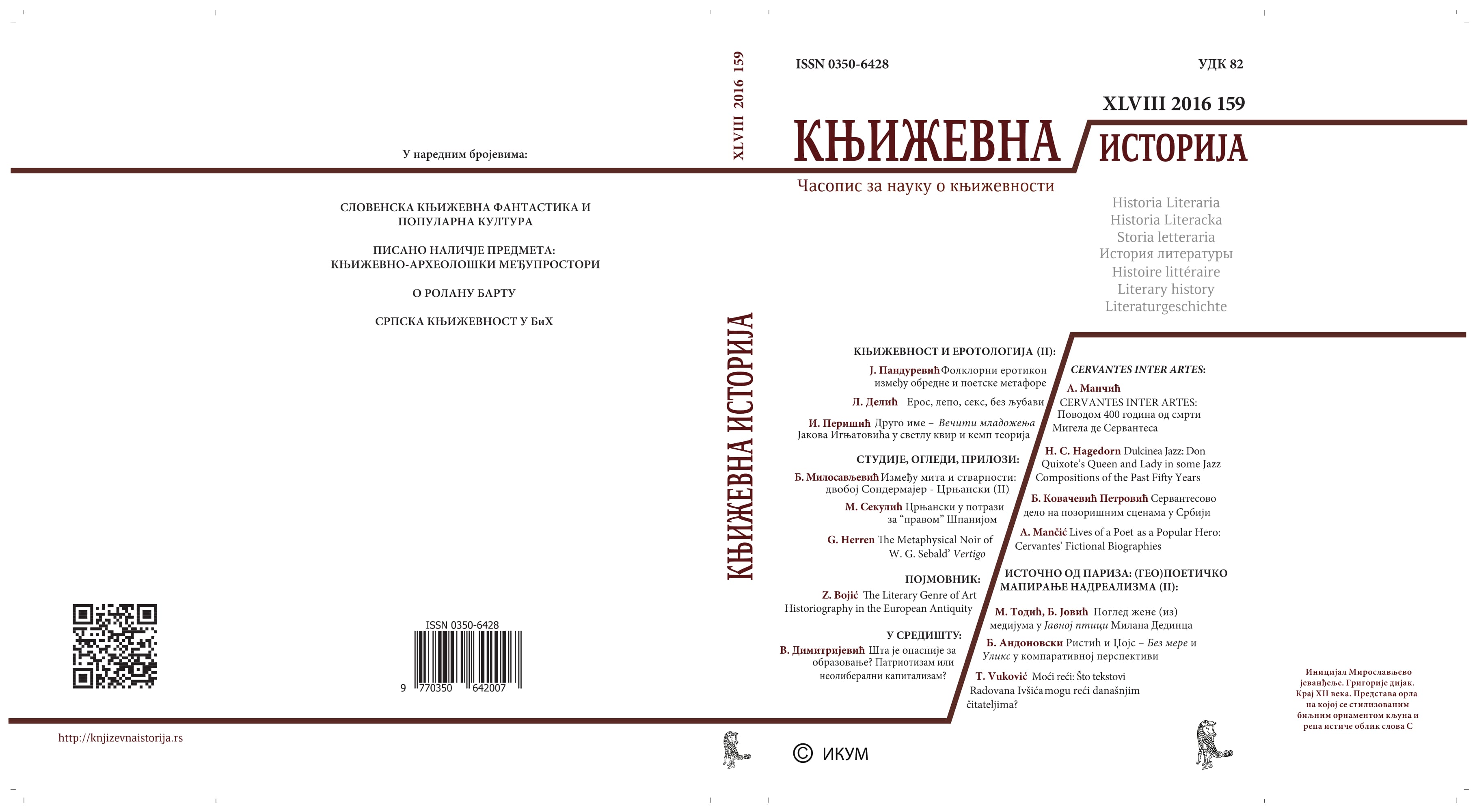
We kindly inform you that, as long as the subject affiliation of our 300.000+ articles is in progress, you might get unsufficient or no results on your third level or second level search. In this case, please broaden your search criteria.





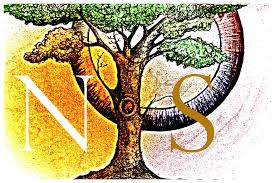
The article comprises an analysis of My moon friend by the modernist Russian poet and diarist, Zinaida Gippius. Vladimir Solovyov’s theories about the possibility to create a new human (androgyny) as well as Otto Weininger’s ideas about bisexual nature of every human being serve as a starting point for the analysis. The author focuses on the image of the protagonist, the Russian poet Alexander Blok, and sees him as the eponymous moon friend, who possesses features typical of androgynous creatures.
More...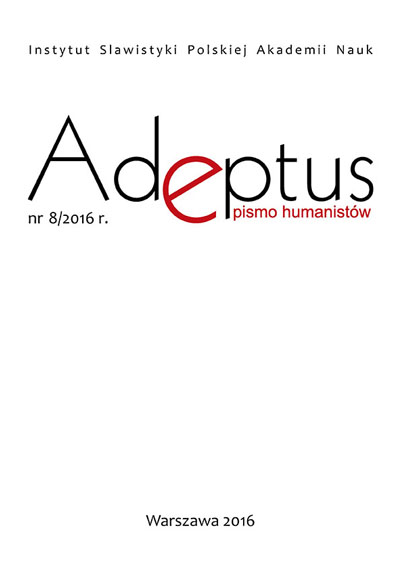
This paper examines photographs, drawings, collages and other art forms collected in the book Babe, edited by photographer Petra Collins and published by Prestel in 2015. I read the collected artwork as an attempt to present the image of the girl (including her sexuality) from a young woman’s perspective. Babe, which includes works such as photographs of teenagers with visible period blood on the underwear or a to-do list with the goal of never faking another orgasm, asks who a contemporary girl is and how young artists can challenge traditional images of femininity. In my analysis I focus on the excessive use of the color pink in Babe, characterizing the way artists blend innocence with eroticism. I argue that by playing with artifacts of “girlishness,” artists can both expose the absurdity of the image of the girl in popular culture and reclaim symbols of girlhood. I suggest that Collins – despite her ambitions to create an inclusive platform for female artists – does not present a diverse image of girls, who in Babe is still predominantly white and able-bodied. I introduce the potential reading of Babe as a feminist visual manifesto, in reference to the Riot Grrrl movement and the cultural phenomenon of “girl power.” I suggest that the book offers a possibility of exploring the figure of the girl from the perspective of young female artists.
More...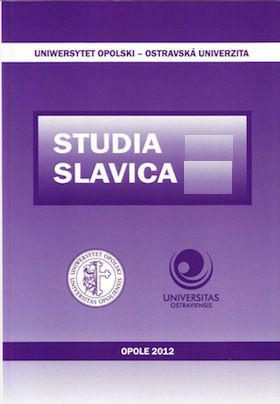
The subject of research in this article are the grotesque creations of senile body present in the novel ofSlobodan Novak „Fragrances, Gold and Frankincense”. Based on Bakhtin’s theory of the grotesque body theauthor distinguishes various creations of senile body in the form of hybridization, zoomorphisation or humanbody objectification. In the grotesque representations of the senile body, the author also perceives the ritualsof food consumption and body orifices discharge, known inter alia from ribald prose of François Rabelais.
More...
Antonio Tabucchi is one of the most representative authors of contemporary Italianliterature. His output includes a short story for children entitled Isabella e l’ombra, which wasillustrated by Isabella Staino and to whom the story is dedicated. Instead of relying on words to writeshort texts at school, the main character, a little girl named Isabella, uses colours and explains their chromatic compositions to the teacher. Undoubtedly, the writer’s pedagogical intention behind thisstory is for young readers to understand that literary expression does not occur only by writing butalso through images and colours that can transmit as many emotions as written texts do. Moreover, thetext, which can be considered a Bildungsroman for children, touches upon some topics visible in othernovels and stories by Tabucchi. This paper aims to analyse the way in which Tabucchi shares some ofhis existential ideas with a non-adult audience, particularly regarding the relationship between variousforms of language, the symbolism of colours, the power of visual communication, and the importanceof such feelings as sadness, affection, and generosity.
More...
Our research intends to find selection parameters for children’s literature to be used asa fundamental part of a foreign-language curriculum. We achieve this through an analysis of theeducational and cultural-linguistic advantages of this literature. Our project’s goal is to expose ourstudents to Italian literature using their second language, rather than their first one, as a way toconvey cultural meaning. This educational project was conducted in 2015, in a school in Chicagothat offers classes of Italian Language and Culture to children at various linguistic levels, includingthe English-Italian bilingual one. Our research paper is divided into three parts. The first partintroduces a theoretical excursus on the meaning of children’s literature and on the fable’s structureas a literary genre. The second part presents examples of how a specific text (L’albero delle fiabe byRoberto Piumini) was selected and used during the project; this part also includes our comments basedon the observations of the child participants. Finally, the analysis stage describes the generalisationof our data within a framework indicating how to select a literary text, which may be useful for otherteachers when deciding which children’s books to use and how to apply them to educational curricula.
More...
This paper analyses the publishing trends of children’s literature in Italy on the basis of theannual reports issued by LiBeRWEB. The analysis, which focuses on the book publishing market,starts by introducing the main Italian publishing houses, in whose hands the publication of children’sbooks is concentrated. The paper will also talk about independent micropublishing by introducingthe most active publishing houses, which are specialised in specific areas, such as gender studies.The publishing market will be progressively investigated by analysing several data, which suggestthat literature for children and young adults is the driving segment of the Italian book publishingmarket. Indeed, despite the economic crisis, this is the only segment that has had positive results inthe last years. In particular, the data examine several elements, which will allow us to understand sucha phenomenon. If in the last years the so-called “high literature” has lost many percentage points (-7.6%in 2009), the “Cinderella of literature” has, instead, obtained positive results (+4%), maintainingconstant production levels. Despite the use of percentages, the analysis takes into consideration otherelements, like the quality of works, whose criteria are difficult to establish. The data show a positivechange: if up to 2006 the number of novels of mediocre quality was high, probably do to a consumertrend of the market, from 2007 onwards, the situation progressively improves. Finally, the articlebriefly discusses the data of the digital market by analysing the role of audiobooks and e-books in theItalian market of children’s literature.
More...
In an attempt to find a possible criterion according to which to select the most representativetitles and authors in the history of Italian children’s literature, one finds that a very peculiar themecharacterises the books that can be considered most remarkable: death. Death, though, in Italian aswell as in all the other children’s classics around the world, is not dealt with in a literal way, but in a metaphorical, symbolic, indirect one. Therefore, it is necessary to borrow interpretative approachesfrom other scientific fields (anthropology and philosophy, for example) in order to understand death’s deepest meaning and to discover that what it stands for, in Italian (and not only Italian) children’s literature, is an “otherness”, a “beyond”, an unknown and non-anthropocentric dimension that children must go through in order to grow up.
More...
A small community of Italians lives in Croatia, mainly in the area of Istria and in thecity of Rijeka, in a multi-ethnic and multicultural environment of history and tradition. The national Italian community in Croatia has an autochthonous presence and tries to preserve its own national and cultural identity. This is done especially through intense and polyhedral artistic activity, ranging from literature to theatre and music, from painting to sculpture, and from photography to design. In 1952, in order to keep up with the cultural development of this community, the publishing house EDIT (EDizioni ITaliane) was founded. In Croatia and abroad, it publishes and promotes books dedicated to Italian authors from Istria and Rijeka, with a series focused on memoirs; modern and contemporary fiction; poetry; and literature for children and youth. Thus, it supports the literary creativity of the writers living in this area. In order to address childhood, EDIT started a junior series called “LaFionda” in 2005, with the mere intention of pointing out the ludic dimension of books and of rousing the imagination of young readers. This article examines the connection of this series to literature for young readers through the analysis of the works of the authors promoted by “La Fionda,” positioning these authors in the socio-historical environment in which they were working. The series expressly attempted to conduct a linguistic investigation linked to artistic and literary reflections within these publications.
More...
This article sets out to explore the dynamics through which Joyce’s version of the legendof the “devil’s bridge”, narrated in a letter addressed to his grandson, Stevie, entered the world ofchildren’s literature in Italy. This occurred just after the legend’s publication in the USA and the UKunder the title The Cat and the Devil. It was immediately turned into a picturebook, a sophisticated literary product aimed at very young readers. In fact, far from being a mere text for toddlers, the ItalianIl gatto e il diavolo is at the centre of several intersemiotic and interlinguistic translations that enhancethe interpretative potential and richness of Joyce’s narration, already at the crossroads between folkloric and modernist translation. The comparative analysis of three different Italian translations ofthe story expressly addressed to children (the first by Enzo Siciliano, published by Emme Edizioniin 1967; the second by Giulio Lughi for Edizioni EL in 1980; and the third and more recent one byOttavio Fatica for ESG in 2010) has highlighted that the differences between them can be ascribedto distinct translation projects, aimed at building bridges between young readers and Joyce’s work invarious periods of the history of the Italian literary market for children.
More...
In the last 20 years in Italy, thanks to the continued effort of qualified authors, children’sliterature has radically renewed, becoming an interesting workshop where different techniques andstyles are tried out, and where important issues, sometimes even awkward ones, are confronted in anadequate way. In this panorama we find the bestseller of Paola Zannoner, Voglio fare la scrittrice, which was published in 2007. Its protagonist, Mia, is an average teenager who belongs to an averageItalian family. This apparent normality is the strength of this character: girls can identify with her. Amusing and interesting, the text is an observation instrument of the modern Italian family: teenagers who criticise adults, family not fitting into traditional stereotypes, and parents who remain eternal children. The text contains pros even on an educational level by means of interesting metalinguisticreflections: practical tips for writing a good narrative text provided directly by a young girl whose dream is to become a famous writer. This strategy is functional: it connects young female readers with the typical constructs and technical terms of writing workshops, intending to begin to develop inreaders a focused textual competence.
More...
This article proposes a reflection on a tale that can be a bridge between “literature forchildren and teens” and “literature for adults”: The Bears’ Famous Invasion of Sicily by Dino Buzzati.It offers a link between fable and fantasy novel and contains all of the elements of the fairy tale thatVladimir Propp planned in 1928: loss, departure, challenges to overcome, reward, and return. It isclosely connected to its historical reality (the period after the Second World War), but at the sametime it detaches itself from that period through the fantastic element. In short, the book is a mirror ofBuzzati’s literary personality and the first literary work of a restless but sensitive author who alwaysfelt linked to painting and writing, to adults and children, to reality and evasion.
More...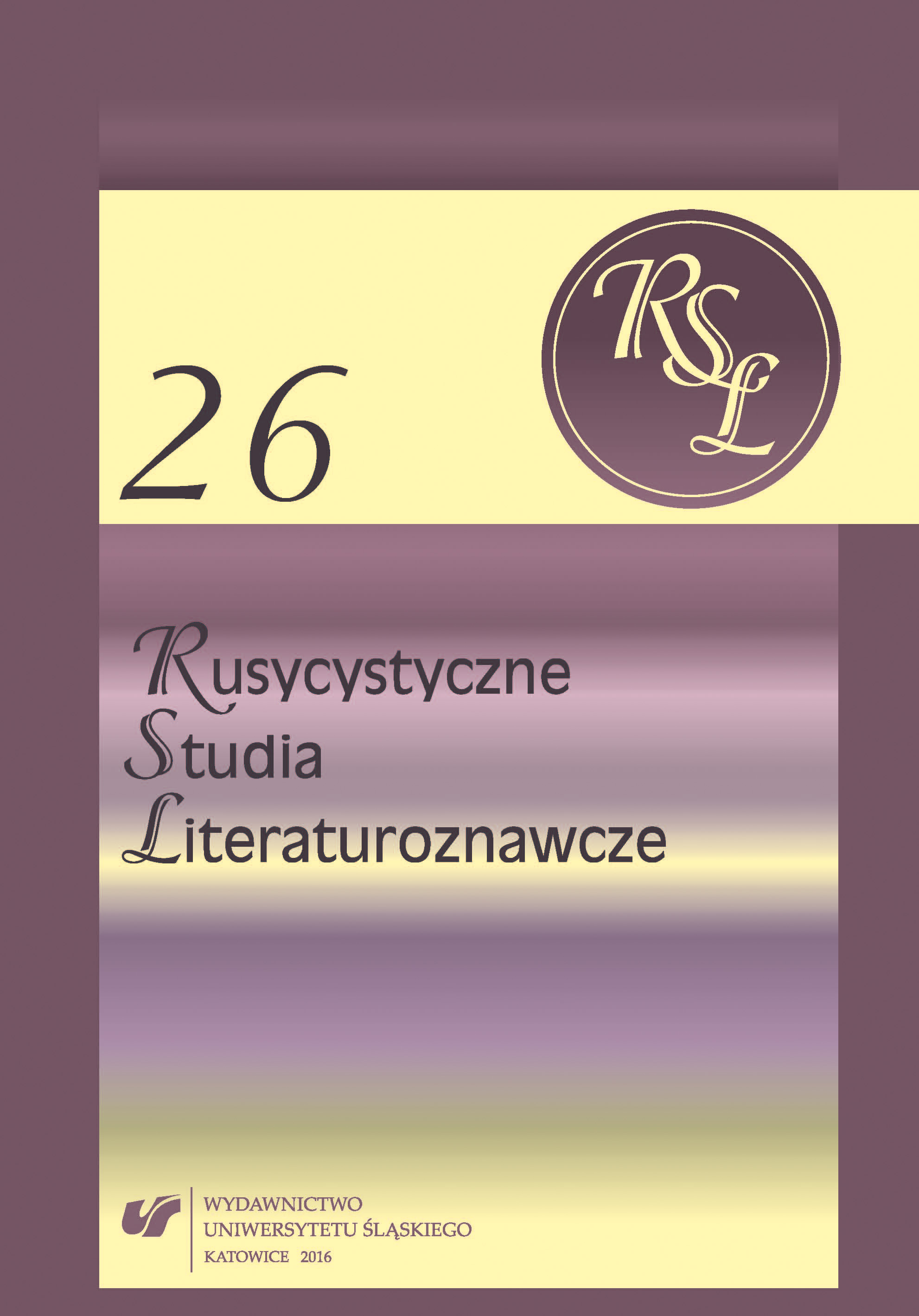
The paper analyses the selected works by Mikhail Arstybashev in the context ofthe naturalist vision of a human being and the motif of crime. Arstybashev perceives civilization as a destructive force inflicting harm upon human beings and inciting their worst instincts. As he believes, only living according to nature makes it possible to achieve serenity.
More...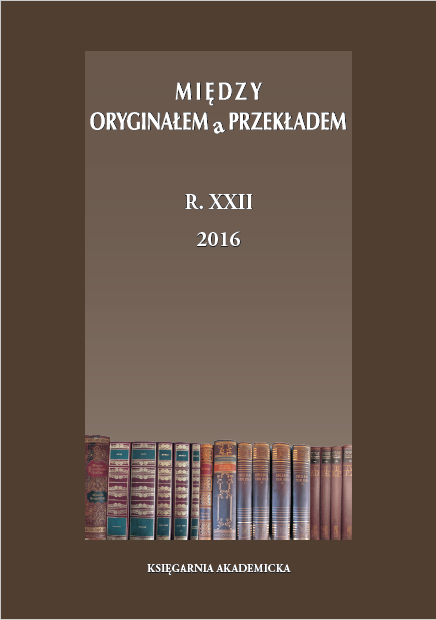
On the basis of the two chosen examples of German literature – Robbers’ Band by Leonhard Frank (1914, Polish edition 1937, translated by Wanda Jedlicka) and From the Snail’s Diary by Günter Grass (1971, Polish edition 1991, translated by Sławomir Blaut) – the author analyses the strategies of translating dialect expressions understood as distinctive codes. A specific dialogue between the styles is the specification of in- ternal worldviews in the linguistic shaping of an expression, which is a special task for a literary translator.
More...
The history of Polish translation of ancient tragedies begun in XIX cen- tury, when drama was considered to belong to the realm of literature rather than to the realm of theatre and when its theatrical values were considered as less important than those literary ones. But in V BC – in a century when the most distinguished ancient playwrights presented their plays – they were definitely regarded as works whose aim was to be presented on theatre stage. Thanks to some theatrical movements at the turn of XXth century, drama regained its due honours and place but still there is no unanimity among the scholars about many issues concerning translation of any ancient tragedy. They still raise questions about the connection between literature and theatre, or the connection between possible staging inserted in the words of drama and the stage possibili- ties from the translator’s time; how the literary or theatrical norms influ- ence the translators’ decisions; should a translator facilitate the reception of a translated text or should he/ she make it difficult; are there any bor- ders or limits of a translation. I would like to dedicate the paper to some of those problems any translator of any ancient tragedy is supposed to solve, but especially to find the answer whether the existing norms or tradition of translation of those particular texts influence the translators and how they deal (discuss or change) with them.
More...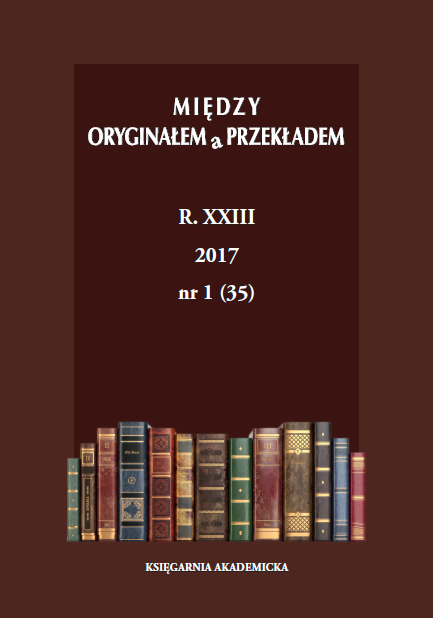
The article presents Lewis Carroll’s Alice’s Adventures in Wonderland as a classical work within the genre of fantasy, or literature of nonsense. The classification is made according to the “five procedures,” postulated for the genre by the American poet and scholar, Susan Stewart. From the point of view of the translator, the procedures make it possible to define the dominant of the book as the tension between the sane protagonist and the mad world of Wonderland. The criterion of dominant, combined by requirements imposed by double readership, makes it possible to characterize Polish translations of the book, which make a translation series. What becomes a challenge for the translator is the wide context of the book, which changes over time. It is possible to trace, within the series, some general tendencies, as well as to demonstrate that, ultimately, translating Alice becomes “translating Alice.”
More...